July 13, 2017
Time will tell…
I believe that one of the most useful definitions of innovation comes from the US Department of Education. It’s a particularly good definition because it considers a critical element forgotten in many others definitions—scale.

Often, our associations with “innovation” relate to how dynamic it is—how it impacts the status quo. This definition, however, points out that impact without scale is only “invention.” It takes both impact and scale combined to result in true innovation.
Most would agree that personalizing learning would have significant impact on the status quo. It seems that personalized learning currently qualifies as an “invention” as it has had an impact in some places, but it clearly has not yet reached broad scale. Will time judge personalized learning to be just an invention, or will it achieve “innovation” status? The deciding factor will be the extent to which scale is achieved.
A lack of scalability
Much too often, standing in the way of the success of personalization has been the lack of scalability—being able to extend relevant practices to an entire class, the whole school, or even a school district. However, what is different now is the availability of technology. Personalized learning is not a student sitting in front of a computer all day long, that would represent a pendulum swing that makes us no better off. What we’re referring to is the use of technology to reduce the burden on teachers in areas such as identifying worthwhile learning resources, compiling and looking at data, and planning. At Renaissance, we’ve performed a series of studies showing that the average teacher spends eight to 10 hours a week planning.
Most of those teachers are planning for the traditional model, maybe with a little bit of differentiation. And those are hours spent before school, after school, at night, and on the weekends, in addition to teaching all day long. If those teachers are spending eight to 10 hours a week to plan fairly standard instructional content, what hope is there for them to be able to personalize? There’s no time left. Under the individualization aspects of a personalized learning model, students transition from one unit to the next at varying times, which requires a lot of paperwork and a lot of tracking. If teachers are already tapped out, where would the hours come from to help them stay on top of this planning and record keeping burden?
That’s where the right kind of technology such as Renaissance Star 360®, can help reduce planning time by pairing assessment results with instructional resources. If that work were done manually, handling the continual assess-plan-instruct activities of personalized instruction would be nearly impossible. With more student data available than ever before, teachers are able to see where their students are at, how they’re progressing, and how they compare to others. Challenging, relevant content can be assigned to students with the click of a button. Without technology, personalizing learning would be a huge burden on teachers and take up time that they already don’t have.
Small steps
Personalized learning isn’t something that can be accomplished overnight. It takes time and involves a tremendous shift away from the way we’re used to thinking about education. It starts with small steps, such as introducing new bits of student data to teachers, or asking them to do one thing differently in their classrooms. Slowly, these methods can help scale personalized learning and make it a reality.


